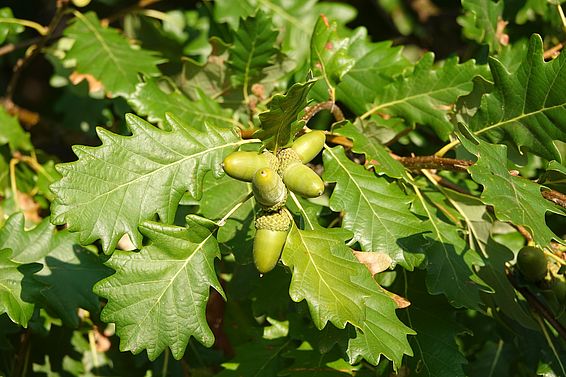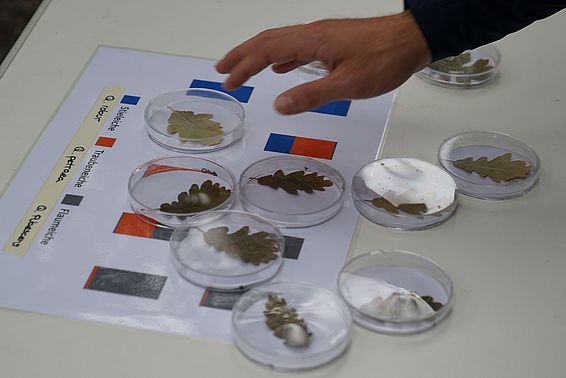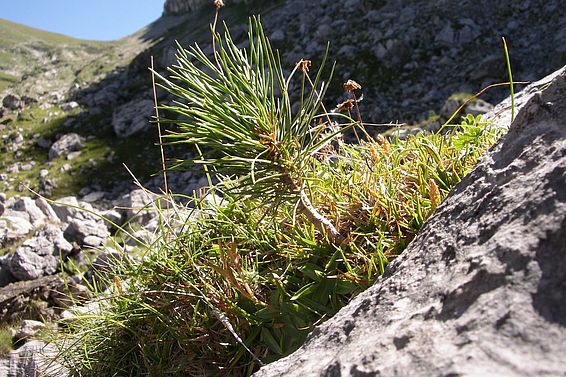11.10.2021 | Stephanie Kusma | News WSL
How can studying the genetic make-up of trees help forests adapt to a future climate? This was one of the topics discussed by researchers at the first international EVOLTREE Conference held at the Swiss Federal Institute for Forest, Snow and Landscape Research (WSL) in Birmensdorf.
The Emmental valley is home to a yew tree that is over a thousand years old. While most trees are considerably younger than this, they are still among the longest-lived organisms in nature. This can be a disadvantage in a changing climate: should environmental conditions deteriorate, the ability to respond quickly, either by adapting or moving to a more favourable location, is vital.
Slow to adapt ¶
This is difficult for tree populations. First of all, it takes years for trees to even produce seeds, and they then do so over decades. "This means offspring is suited to the conditions under which their parent trees grew, rather than being adapted to current conditions," explains Felix Gugerli, one of the organisers of the first international conference of the EVOLTREE network, which took place at WSL's Birmensdorf site in September. Trees are therefore always decades, and possibly even centuries, behind the prevailing conditions.
In working forests, it takes years before trunks can be harvested, years during which the trunks may grow under suboptimal conditions and therefore produce poorer yields. How genomics can help address this time lag and create climate-smart forests was one of the topics addressed at the conference.
Genetic diversity is vital ¶
Many tree species are actually genetically predisposed to adapt to different locations, at least to a certain extent. For this to happen, however, the species as a whole must possess a range of gene variants. If so, an individual tree growing in the 'wrong' place may die but a conspecific may still thrive, meaning that the species will survive in that location. This genetic variability (i.e. the diversity of genes) is a cornerstone of biodiversity.
In the case of short-lived species, rapidly changing environmental conditions can help to preserve this variability, as John Kelly from the University of Kansas explained at the conference. He is studying the yellow monkey flower (Mimulus guttatus) on Iron Mountain in Oregon, USA. These tiny flowers grow at such an altitude that they have only a few snow-free weeks each year to grow, flower and produce seeds.
If the snow holds off for a few days longer, the plants that grow taller 'win', as they produce more seeds. If, however, it snows earlier than usual, the 'winners' are those that remain small and produce fewer seeds – but seeds that ripen earlier. Since the conditions keep changing, both 'versions' of the plant remain in play, and researchers can identify the gene variants underpinning these properties.
Genetic material that confers drought resistance ¶
A tree stand does not react as quickly as a population of monkey flowers. This is where the analysis of seeds or seedlings could help. "Seeds contain the whole genetic potential of a species," explains Gugerli. Analysing them could help to identify gene variants that are particularly advantageous in current environmental conditions. If, for example, a tree reproduces remarkably well, this could indicate that a gene variant or combination of gene variants is allowing this tree to adapt. If the season in question was warmer than usual, for instance, the tree may have done particularly well for that very reason.
Greenhouse experiments are another way to pinpoint beneficial gene variants. For example, Rafael Candido Ribeiro from the University of British Columbia and his colleagues exposed over 1,400 Douglas fir seedlings (Pseudotsuga menziesii) to drought conditions. These had been grown from seeds taken from a wide range of locations. The seedlings survived the artificial drought for different lengths of time, and the researchers managed to identify parts of the seedlings' genome that are likely to be related to an increased drought resistance.
However, greenhouses are not always needed to achieve such results. Jill Sekely from the University of Marburg used an outdoor laboratory to carry out her research on the lenga beech (Nothofagus pumilio). This species grows in the Andes, not only in a north-south range spanning hundreds of kilometres but also on mountainsides at a variety of altitudes. Sekely was ultimately able to identify gene variants linked to the different environmental factors at these very different locations.
Devrim Semizer-Cuming from the Forest Research Institute of Baden-Württemberg presented a project involving oaks that live on dry, unproductive sites. As these sites are of no interest to humans, the trees have been left to grow undisturbed there for centuries and are likely to have adapted to their poor living conditions. Analyses will now identify gene variants that enable the oak to live in dry conditions. "Such knowledge could one day be used in breeding or selecting trees that are better adapted to a future climate," says WSL's Christian Rellstab, who was co-organiser of the conference and participated in the oak project.
Oak hybrids in Swiss forests ¶
Genetic Analyses of trees whose parents belong to two different species could also prove useful here. In such hybrids, the genetic material of two species mixes and, with a bit of luck, this mixture will give the hybrids an advantage in a location where their parents thrive less well. Moreover, hybrids can pass on favourable combinations of gene variants to their own offspring. "Hybridisation both increases genetic diversity and enables the transfer of advantageous gene variants from one species to another through backcrossing" says Oliver Reutimann from ETH Zurich.
However, it can be difficult to recognise hybrids by their appearance, especially when the parent species themselves are difficult to tell apart, even for experts, as is the case with the sessile oak (Quercus petraea) and the downy oak (Q. pubescens). That is why the WSL study presented by Reutimann at the EVOLTREE Conference involved using genetic fingerprints to identify the oaks in Swiss forests. The researchers discovered pure populations as well as populations comprising a whole range of trees with varying degrees of mixed genetic material.
The emergence of such hybrids is not a new phenomenon. "But it is possible that they now have an advantage over the parent species in certain locations," says Rellstab. For example, the study found that there was a greater proportion of hybrids in places with highly fluctuating environmental conditions. They may manage to survive in places where their parents can no longer thrive due to climate change. This could also lead to the emergence of new species. "A very high percentage of the plant species living today are believed to be the result of hybridisation," notes Gugerli.
Human assistance needed ¶
Sometimes, however, adaptation is not necessary at all, namely when there are actually suitable habitats available, if only they could be populated. This is where some species, such as the Serbian spruce (Picea omorika), may founder. At the conference, Jelena Aleksić from the University of Belgrade presented an ambitious plan to save this characteristically tall, narrow conifer, which is one of the rarest tree species in Europe. This plan revolves around planting the tree in new, suitable habitats in Northern Europe (a process known as 'assisted migration') and thus saving the species from the growing threat of global warming and competition from other tree species.
In Switzerland, we could adopt such an approach with the Swiss stone pine (Pinus cembra), for instance. As Gugerli explained at the EVOLTREE Conference, this tree exhibits considerable genetic diversity but does not move to higher sites quickly enough, while the faster-migrating and more competitive spruce is pushing in from below. The spotted nutcracker (Nucifraga caryocatactes) also plays a role in the tree's slow upward spread, as the bird has no reason to move its stores of Swiss stone pine seeds above the current forest line. Humans, however, could give the tree more time to adapt and spread by artificially reducing the pressure from the spruce by felling spruce - or instead of felling spruce plant Swiss stone pines in higher altitudes (which is a more labour-intensive undertaking).
Then, however, it would be useful to be able to select the right trees – those that will still thrive in their locations when these eventually become warmer and whose future offspring have the greatest possible chance of survival. Such decisions may one day be made easier thanks to the knowledge gained from genome analyses. This knowledge may also contribute to the conservation of genetic diversity and species in their habitats.
Adaptability to climate change was not the only topic addressed at the EVOLTREE Conference. Researchers held a number of lectures and poster sessions, showcasing a wide range of studies involving trees and their cohabiting organisms. They looked at the genetic material of these species from an evolutionary perspective, presented new methods, analysed population differences in the spatial or – using ancient DNA – temporal distribution of gene variants, and examined correlations between ecological and genetic factors that indicate evolutionary adaptation to environmental variation.
Contact ¶
Projects ¶
Publications ¶
Copyright ¶
WSL and SLF provide image and sound material free of charge for use in the context of press contributions in connection with this media release. The transfer of this material to image, sound and/or video databases and the sale of the material by third parties are not permitted.




